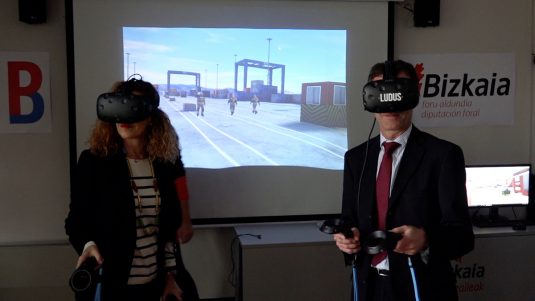The Port Authority of Bilbao and the Territorial Council of Biscay have presented a virtual simulator that will enable the Council’s firefighters to train in real Port of Bilbao scenarios and simulate different emergency situations. This makes the Territorial Council’s Fire Prevention, Extinction and Salvage Service the first emergency service in Spain to have such technology for their training, which up to the present, was only used in the aeronautics and military sectors. The transformation that virtual technology reality has undergone in the last three years has made it accessible for developers and has allowed it to become more popular and reduce its costs.
The virtual reality simulator allows for the training of 76 officers of the Council’s Firefighting Service – mainly corporals and sergeants, who are the ones to intervene initially in emergency calls, and assess at the end of every action the decisions taken throughout. In this first phase specifically, three different intervention drills have been designed for inclusion in the simulator for incidents in the Port of Bilbao: an accident involving a vehicle carrying hazardous goods, a fire in a Port warehouse and a prevention post.
The simulator offers realistic contexts where operations can be carried out safely and in spaces that are in use without any need to evacuate the zone. In addition, this technology enables the rehearsal of emergency situations that would be impossible to reproduce in real life, and so it is an ideal complement for traditional practice drills.
The technology used to develop the simulator scenarios is based on the Unity3D videogames and simulation engine, adapted here to the needs of firefighters operating in the Port of Bilbao, and which allows several persons to be trained at the same time. Besides, it generates data to analyse each exercise. The simulation also allows for the inclusion of unforeseen variables such as adverse weather conditions or high risk situations, thus testing the fire service officers’ capacity to react.
The scenario designs have been achieved through photographs and web servers map applications, and thanks to them, 3D images have been built. Several sensors installed in the training room at the Urioste Fire Station limit the training area, and it is necessary to wear special glasses connected to the application which submerge the trainee into the scenario. The application can receive orders either with special controls or verbally and has two screens: one is used for supervision, while the other is for visualising the image being seen by the person who is training and wearing glasses. If there are other people

in the room, this makes it possible to analyse the decisions being taken at all times.
Collaboration agreement between the Territorial Council and the Port Authority
The introduction of the virtual reality simulator has been made possible thanks to the collaboration agreement between the Port Authority and the Territorial Council, which has been in force since 1996, and whereby the Council’s Fire Services are constituted as a “Port of Bilbao Intervention Group” as set out in the Port’s self-protection plan. In return for the Council’s firefighting services the Port Authority is committed to providing the technical means as well as the necessary training regarding their intervention in possible accidents in the Port of Bilbao.
As a result of this agreement, the Port of Bilbao is at the head of the Spanish Port System in terms of its capacity to respond to possible disasters originating from dangerous goods.
The present agreement was signed in 2011. Throughout this time, the Port Authority has provided the Biscay firefighters with an intervention container dedicated to chemical emergencies; a bilge pump and fork lift truck capable of acting in explosive atmospheres; a light fire vehicle equipped for emergency chemical interventions; a mobile container with a two-kilometre long hose; a Rolltrailer for gathering leaks from dangerous goods; 440 firefighting outfits whose design and features were carried out according to the opinions of the Council firefighters themselves and a state-of-the-art heavy duty fire vehicle.
The virtual reality simulator has now been added to all this equipment, whose development has supposed eight months’ work and 97,000 euros investment. In fact, over the last five years, the Port Authority has made investments totalling 1,200,000 euros on equipment for the Council’s Firefighting and Salvage Service.

 Port access
Port access